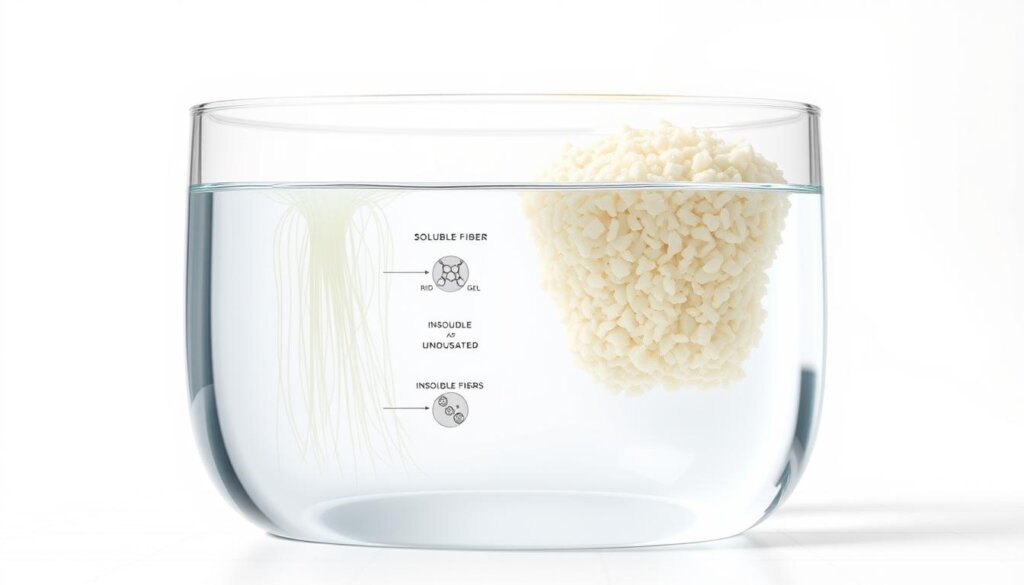Did you know over 90% of adults fall short of daily fiber recommendations, yet some accidentally consume too much? While most struggle to meet their needs, exceeding the ideal intake can trigger bloating, cramping, or constipation—issues that catch many by surprise.
Fiber plays a vital role in digestion and overall health, but balance matters. Guidelines suggest roughly 14 grams per 1,000 calories consumed daily. For those suddenly increasing their intake—like adding extra chia seeds or whole grains—the digestive system may rebel with uncomfortable symptoms.
These reactions often stem from rapid dietary changes rather than long-term habits. The good news? Adjusting portions or hydration levels usually resolves discomfort quickly. This article explores how to recognize when your body signals overload and offers practical steps to find your ideal fiber balance.
Key Takeaways
- Excessive fiber intake is rare but can cause bloating, gas, or constipation.
- Most people need more fiber, not less, in their diets.
- Digestive discomfort often relates to sudden increases in fiber consumption.
- Gradual adjustments and proper hydration help manage intake effectively.
- Understanding personal tolerance supports long-term digestive wellness.
Introduction to Dietary Fiber and Its Role in Health
Fiber acts as your body’s natural maintenance crew—keeping systems running smoothly while preventing long-term wear and tear. This nutrient does more than support regular bathroom visits. It helps manage cholesterol, stabilizes blood sugar, and feeds the friendly bacteria in your gut.
Why Fiber is Essential

Click to 了解更多
Dietary fiber works like a sponge in your digestive tract. Soluble types absorb water to slow digestion, helping you feel full longer. Insoluble varieties add bulk to stool, preventing constipation. Together, they create a balanced environment for gut microbes linked to immune strength.
Studies show consistent fiber intake lowers risks for heart disease and type 2 diabetes. It also helps maintain healthy blood pressure levels. These benefits make fiber a cornerstone of preventive healthcare.
Overview of Dietary Recommendations
The USDA suggests 14 grams of fiber per 1,000 calories consumed daily. Most adults need 25-38 grams per day, but needs vary based on activity and health goals. Use this simple formula:
| Daily Calories | Fiber Target |
|---|---|
| 1,500 | 21 grams |
| 2,000 | 28 grams |
| 2,500 | 35 grams |
Gradual increases paired with hydration help your body adjust without discomfort. Start by adding one high-fiber food each day—like oats or lentils—and build from there. This approach supports lasting digestive wellness while maximizing nutrient absorption.
Understanding Dietary Fiber: Soluble vs. Insoluble
Not all fibers work the same way. Your body uses two main types of dietary fiber like a skilled team—each with unique roles in digestion and health.

Types of Fiber and Their Functions
Insoluble fiber acts as nature’s broom. Found in plant skins and leafy greens, it sweeps through intestines undigested. This adds bulk to stool, helping prevent constipation.
Soluble fiber works like a sponge. When mixed with water, it forms a gel that slows digestion. Found in oats and beans, it feeds gut bacteria and softens stools gently.
Healthy Sources of Fiber
Balancing both types ensures smooth digestion. Try these common foods to get a mix:
| Soluble Fiber Sources | Insoluble Fiber Sources |
|---|---|
| Oats & barley | Whole wheat bran |
| Chia seeds | Broccoli stems |
| Lentils | Apple skins |
| Psyllium husk | Brown rice |
Combining these sources creates digestive harmony. For example, pair oatmeal (soluble) with berries (insoluble) for breakfast. This duo supports regularity without overwhelming your system.
Remember—variety matters more than perfection. Rotate different foods throughout the week to nourish gut bacteria and maintain balance naturally.
What are the symptoms of too much fiber?
Ever felt uncomfortably full after a fiber-packed meal? While fiber supports digestion, overdoing it can backfire. Recognizing early signs helps prevent prolonged discomfort and supports better gut health.
Common Digestive Symptoms
Bloating and gas often top the list of complaints. These occur when gut bacteria ferment excess fiber, creating trapped air. Constipation may surprise many, especially since fiber usually relieves it. Without enough water, fiber hardens stool instead of softening it.
Temporary weight fluctuations sometimes follow high-fiber meals. This results from water retention and slower digestion. Most find these issues resolve within days by adjusting portions and hydration.
Less Common but Serious Side Effects
Prolonged overconsumption might hinder mineral absorption. Soluble fiber can bind to iron or zinc, reducing their availability. Those with digestive conditions like Crohn’s disease face higher risks of blockages from dense fiber intake.

Click to 了解更多
Though rare, severe cramping or persistent bowel changes warrant medical attention. Listening to your body’s signals helps maintain balance without sacrificing fiber’s long-term benefits.
Factors Influencing Excessive Fiber Intake
Your journey to clean eating could accidentally overload your system with fiber. Plant-focused diets like vegan or raw food plans often pack double the recommended daily intake through constant use of legumes, whole grains, and vegetables. While nutritious, these choices demand careful balancing to avoid overwhelming your gut’s processing capacity.
Dietary Habits and Sudden Increases
Switching overnight from low-fiber meals to high intake levels shocks the digestive system. Gut bacteria need 7-10 days to adjust fermentation processes for breaking down fibrous material. Without this adaptation period, expect:
- Bloating from rapid bacterial gas production
- Hard stools if water consumption lags behind
- Temporary nutrient malabsorption
A 2023 nutrition study found participants who increased fiber gradually—adding 5 grams every three days—experienced 60% fewer side effects than those making abrupt changes.
Interference with Nutrient Absorption
Excessive soluble fiber acts like a magnet in your intestines. It can bind to minerals like iron and calcium, reducing their availability. One cup of lentils provides 19 grams of fiber—enough to impact zinc absorption if eaten with every meal.
“Space high-fiber foods 2-3 hours apart from supplements or mineral-rich meals for optimal nutrient uptake.”
Those following strict plant-based diets should monitor energy levels and consider periodic blood tests to check for deficiencies. Pairing vitamin C-rich foods with iron sources helps counteract fiber’s binding effects.
Strategies to Manage Excess Fiber Intake
That salad bowl packed with quinoa and kale might leave you feeling worse than before. Finding balance with fiber requires smart adjustments rather than drastic cuts. Simple tweaks to hydration and meal planning often resolve discomfort while maintaining nutritional benefits.
Hydration and Movement Matter
Water acts as fiber’s partner in digestion. For every 5 grams of fiber consumed, drink an extra glass of water. This prevents fiber from hardening in the digestive system and eases bowel movements.
Gentle physical activity like walking stimulates digestion naturally. Try these steps:
- Sip warm lemon water upon waking
- Take 10-minute walks after meals
- Avoid carbonated drinks and chewing gum
Redesign Your Plate Gradually
Cutting fiber suddenly risks nutrient gaps. Instead, swap one high-fiber item daily for easier options:
| Day 1-3 | Day 4-7 |
|---|---|
| White rice instead of brown | Peeled apples vs whole |
| Mashed potatoes over sweet potatoes | Strained soups with veggies |
“Participants who reduced fiber intake saw 40% less bloating within 72 hours.” – 2012 Gut Health Study
Track changes in energy levels and digestion weekly. Most people find relief within 3-5 days while still enjoying fiber-rich foods in moderation.
When to Seek Professional Guidance
While most digestive discomfort resolves with simple adjustments, some situations demand expert evaluation. Persistent nausea, vomiting, or fever lasting over 24 hours signal potential complications. Complete inability to pass stool or gas for three days requires urgent care to rule out intestinal blockages.

Consulting Healthcare Professionals
People with chronic conditions like diabetes benefit from tailored fiber plans. Since fiber impacts blood sugar absorption, mismanagement can disrupt glucose control. Those recovering from surgeries or managing Crohn’s disease often need medically supervised low-fiber diets.
Prepare these questions for your provider:
- Could my symptoms indicate underlying health issues?
- How does fiber interact with my medications?
- What’s the safest way to adjust my intake?
Contact Wellness Group for Personalized Advice
For localized support in Malaysia, Wellness Group offers customized meal planning. Their nutritionists help balance fiber intake while addressing specific blood sugar or digestive needs. Reach them at +60123822655 during these hours:
| Weekdays | Weekends |
|---|---|
| 9:30 AM – 6:30 PM | 10 AM – 5 PM |
“Temporary dietary changes under supervision often prevent long-term health risks while maintaining nutritional balance.”
Seeking help demonstrates proactive care for your body—not failure. Wellness Group’s team simplifies complex dietary adjustments, ensuring people achieve comfort without sacrificing nutrition.
Tips for Balancing Fiber Intake: Practical Dietary Advice
Smart fiber management starts with understanding your body’s unique needs. Adults require different amounts based on age and gender—ranging from 22 to 34 grams per day. Spread intake across meals to avoid overwhelming your system.
Meal Planning and Portion Control
Use this age-based guide for daily targets:
| Age Group | Men (grams) | Women (grams) |
|---|---|---|
| 19-30 years | 34 | 28 |
| 31-50 years | 31 | 25 |
| 51+ years | 28 | 22 |
Pair vegetables with lean proteins instead of stacking multiple high-fiber foods. For example, mix spinach (2g fiber) with grilled chicken rather than combining beans and broccoli in one meal.
Lifestyle Changes for Consistent Fiber Management
Track intake using nutrition labels—aim for 5-8 grams per meal. Store pre-portioned nuts or chopped veggies for snacks. Research shows spacing fiber-rich meals throughout the day improves digestion by 30%.
Rotate fiber sources weekly. Try chia seeds Monday, lentils Wednesday, and oats Friday. This variety feeds diverse gut bacteria while preventing bulk-related discomfort. Most people adapt within 2-3 weeks using gradual increases.
Conclusion
Finding your fiber sweet spot transforms this nutrient from foe to friend. While health benefits like improved gut function and weight management make fiber essential, balance prevents discomfort. Temporary issues like hard stools or bloating often stem from rapid dietary changes—not permanent intolerance.
Successful management relies on gradual adjustments. Add one fiber-rich food every few days while drinking extra water. This allows your system to adapt without rebellion. Pairing soluble and insoluble sources—like oatmeal with berries—supports smooth bowel movements naturally.
Listen to your body’s signals. Mild symptoms usually resolve within days by tweaking portion sizes or meal timing. Those in Malaysia can adapt these strategies using local favorites like brown rice or tropical fruits for balanced intake.
Remember: consistency beats perfection. Small, sustainable changes unlock fiber’s full potential while keeping digestion comfortable. Your journey to optimal health becomes easier when you work with—not against—your body’s needs.
FAQ
Can high-fiber foods cause uncomfortable digestion?
Yes, consuming large amounts of fiber-rich items like beans, whole grains, or cruciferous vegetables may lead to gas, bloating, or irregular bowel movements. Gradually increasing intake and drinking water helps the gut adjust.
How does soluble fiber differ from insoluble fiber?
Soluble fiber dissolves in water, forming a gel-like substance that supports blood sugar and cholesterol management. Insoluble fiber adds bulk to stools, aiding regularity. Both types are essential but require balance.
What steps reduce discomfort from excess fiber?
Staying hydrated, engaging in light physical activity, and temporarily lowering portions of high-fiber foods like lentils or broccoli can ease symptoms. Pairing fiber with probiotics may also improve gut health.
When should someone consult a doctor about fiber intake?
Persistent constipation, severe abdominal pain, or unexpected weight loss despite dietary adjustments warrant professional advice. A healthcare provider can rule out underlying conditions like IBS or nutrient deficiencies.
How can meals be balanced to avoid overconsumption?
Mixing fiber sources—such as oats, berries, and leafy greens—with lean proteins and healthy fats ensures steady energy. Portion control and tracking daily grams (25–38 for adults) prevent sudden spikes.
Does fiber interfere with medication or vitamins?
Excessive intake might reduce absorption of minerals like iron or calcium. Spacing fiber-rich meals and supplements by 2–3 hours helps maintain nutrient levels. Always discuss interactions with a pharmacist or dietitian.






